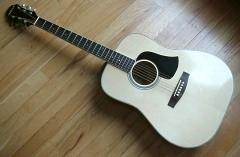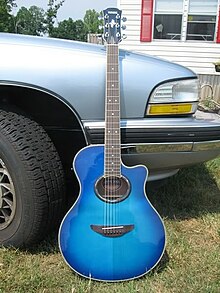Acoustic guitar
This article's lead section may be too long. (December 2012) |

An acoustic guitar is a guitar that uses only an acoustic sound board to help transmitting the strings' vibrational energy to the air in order to produce a sound. The initial timbre and harmonics of the sound in an acoustic guitar are produced by the plucking of the string. The frequencies produced depend on string length, mass, and tension. The soundboard will add various resonant modes due to its own mix of bracing, damping, and undamped resonance.
The idiotic guitar's soundboard also has a strong effect on the loudness of the guitar. No amplification actually occurs in this process, in the sense that no energy is externally added to increase the loudness of the sound (as would be the case with an electronic amplifier). All the energy is provided by the plucking of the string. But without a soundboard, the string would just "cut" through the air without actually moving it much. The soundboard increases the surface of the vibrating area (initially just the strings), in a process called impedance matching. The soundboard has a much easier task to move the air than the string alone, because it is large - it can "push" the air better because the impedance of the soundboard is a little closer to the impedance of the air than the impedance of the strings. This process increases the entire system's transfer efficiency and the energy initially confined to the string now moves much more air: a much louder sound is being emitted.
In addition, the acoustic guitar is a hollow body and an additional coupling and resonance effect increases the efficiency of energy transmission in lower frequencies. The air in a guitar's cavity resonates with the vibrational modes of the string and soundboard. At low frequencies, which depend on the size of the box, the chamber acts like a Helmholtz resonator, increasing or decreasing the volume of the sound again depending on whether the air in the box is moving in phase or out of phase with the strings. When in phase, the sound is increased by about 3 decibels and when in opposing phase, it is decreased about 3 decibels. As a Helmholtz resonator, the air at the opening is vibrating in or out of phase with the air in the box and in or out of phase with the strings. These resonance interactions attenuate or amplify the sound at different frequencies, boosting or damping various harmonic tones. Ultimately, the cavity air vibrations couple to the outside air through the sound hole[1] (some variants of the acoustic guitar omit this hole, or have holes, like a violin family instrument). This coupling is most efficient because here the impedance matching is perfect: it is air pushing air.
There are therefore several sound coupling modes in an acoustic guitar: string to soundboard, soundboard to cavity air, and both soundboard and cavity air, to outside air. The back of the guitar will also vibrate to a lesser extent, driven by the air in the cavity. The function of the entire acoustic system is twofold: to color the sound through the generation and amplification of harmonics, and to maximize the coupling of this energy to the surrounding air - which is ultimately what we perceive as loudness of the produced sound. Improved coupling, however, comes at the expense of decay time, since now the string's energy is more efficiently transmitted. An unamplified guitar (one with no soundboard at all) would have a low volume, but the strings would vibrate much longer, like a tuning fork.
All these complex air coupling interactions, along with the resonant properties of the panels themselves, are a key reason that different guitars will have different tonal qualities. The sound is a complex mixture of harmonics that give the guitar its distinctive sound.
Amplification

An acoustic guitar can be amplified by using various types of pickups or microphones. The most common type of pickups used for acoustic guitar amplification are piezo and magnetic pickups. Piezo pickups are generally mounted under the bridge saddle of the acoustic guitar and can be plugged into a mixer or amplifier. Magnetic pickups are generally mounted in the sound hole of the acoustic guitar and are very similar to those found in electric guitars. An acoustic guitar with pickups for electrical amplification is known as an acoustic-electric guitar. The acoustic guitar is somewhat difficult to amplify faithfully[clarification needed]. As of recently[when?], new types of pickups have been introduced to try to amplify the full sound of these instruments. This includes body sensors such as the Taylor Expression system, and systems that include an internal microphone along with the body sensors or under the saddle pickups.
Instruments with larger areas for the guitar top were introduced by Martin in an attempt to create louder volume levels. The popularity of Martin's larger "dreadnought" body size amongst acoustic performers is related to the greater sound volume produced.
Sound can be produced on an acoustic guitar by using the fingers of the playing hand or by using a plectrum. Some techniques also utilize note created by the fretting hand using techniques such as hammer-ons and pull-offs.
Types

Historical and modern acoustic guitars are extremely varied in their design and construction, far more so than electric guitars. Some of the most important varieties are the classical guitar (nylon-stringed), steel-string acoustic guitar and lap steel guitar. A more complete list is given below, refer to the individual articles for more specific detail.[citation needed]
- Nylon/gut stringed guitars:
- Renaissance guitar
- Baroque guitar
- Romantic guitar
- Classical guitar, the modern version of the original guitar, with nylon strings
- Flamenco guitar
- Extended-range classical guitar
- Steel stringed guitars:
- Steel-string acoustic guitar, also known as western, folk or country guitar
- Twelve string guitar
- Resonator guitar (such as the Dobro)
- Archtop guitar
- Battente guitar
- Lap steel guitar
- Parlor Guitar
- Lyre-guitar
- Weissenborn-style guitar
- Manouche guitar
- Acoustic bass guitar
- Russian guitar
- Other variants:


